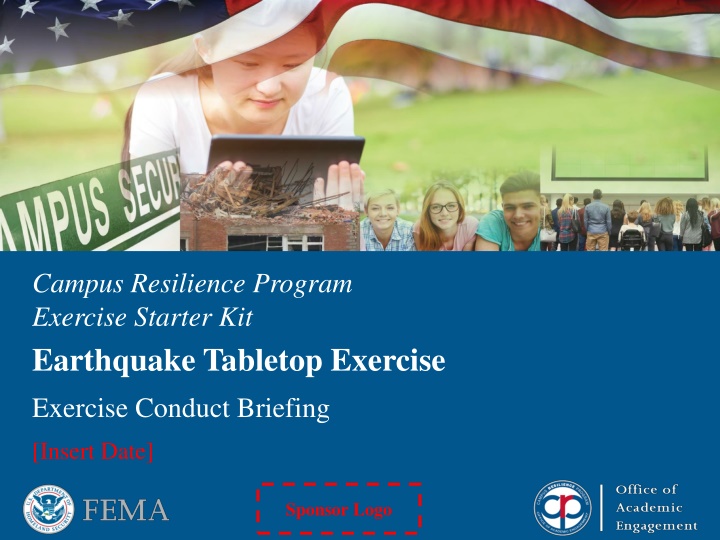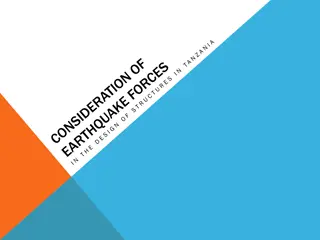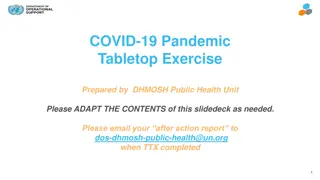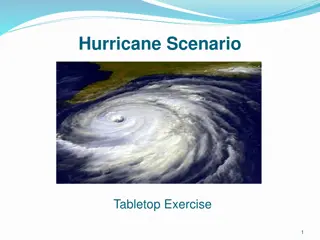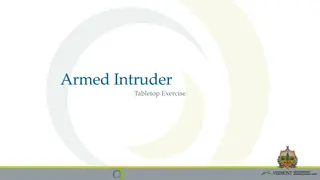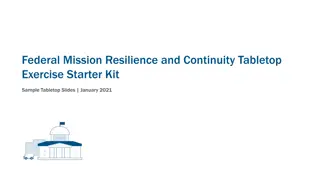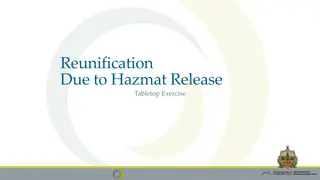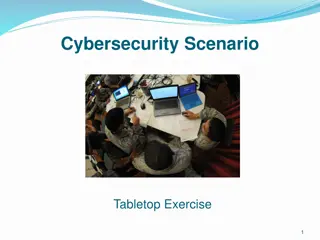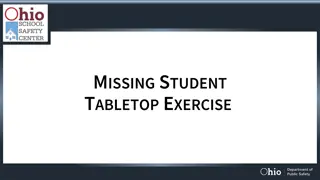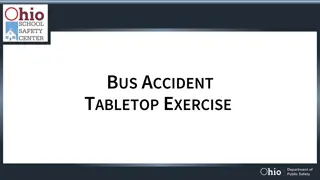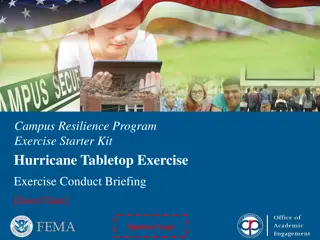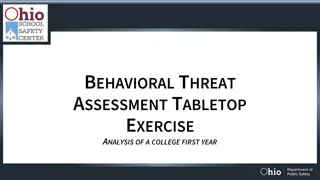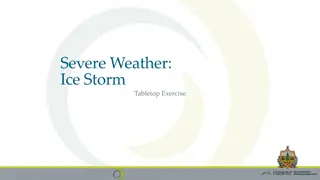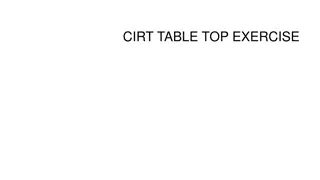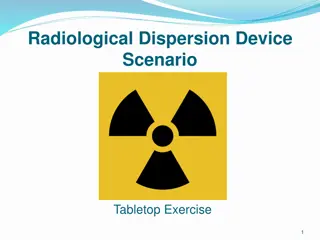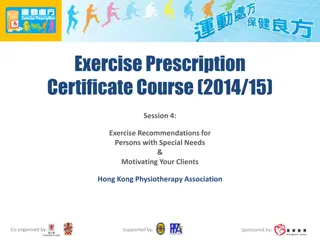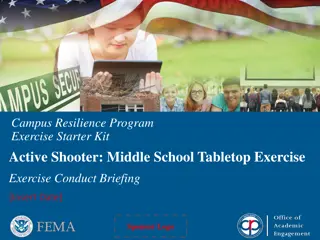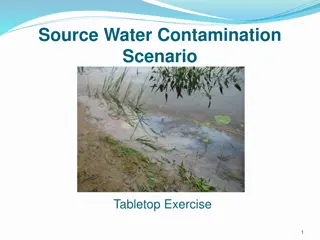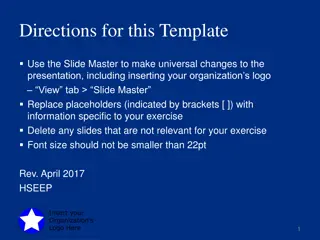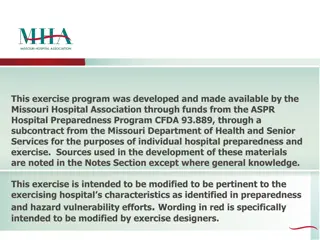Earthquake Tabletop Exercise
This Exercise Conduct Briefing document serves as a foundational tool for higher education institutions to evaluate their emergency plans, policies, and procedures in the event of an earthquake. It includes customizable content to align with specific needs, to be used alongside the Earthquake Situation Manual and Facilitator Guide. The briefing covers key aspects from welcome and introductions to exercise schedule and overview, designed to enhance campus resilience and preparedness.
Download Presentation

Please find below an Image/Link to download the presentation.
The content on the website is provided AS IS for your information and personal use only. It may not be sold, licensed, or shared on other websites without obtaining consent from the author.If you encounter any issues during the download, it is possible that the publisher has removed the file from their server.
You are allowed to download the files provided on this website for personal or commercial use, subject to the condition that they are used lawfully. All files are the property of their respective owners.
The content on the website is provided AS IS for your information and personal use only. It may not be sold, licensed, or shared on other websites without obtaining consent from the author.
E N D
Presentation Transcript
Campus Resilience Program Exercise Starter Kit Earthquake Tabletop Exercise Exercise Conduct Briefing [Insert Date] Sponsor Logo Sponsor Logo
READ FIRST The purpose of this Exercise Conduct Briefing is to provide a baseline exercise document that institutions of higher education can use to assess their emergency plans, policies, and procedures The sample content contained in this document can be tailored as necessary by filling in all [bracketed content that is highlighted in red] To insert the sponsoring organization s logo, navigate to the View menu and select Slide Master This briefing is to be used in tandem with the Earthquake Situation Manual and Facilitator Guide so any changes made to this briefing will need to be aligned with those documents **Delete slide prior to conduct**
Welcome and Introductions [Name] [Title] [Department/Agency/Organization] [Name] [Title] [Department/Agency/Organization] Sponsor Logo 3
Administrative Remarks Cell phone etiquette Evacuation procedures Restroom locations Sponsor Logo 4
Exercise Schedule Activity [Welcome and Introductions] [Exercise Overview] Module 1: Response Break Module 2: Short-Term Recovery Break Module 3: Long-Term Recovery Break [Exercise Hot Wash] [Closing Remarks] Time [00:00 a.m.] [00:00 a.m.] [00:00 p.m.] [00:00 p.m.] [00:00 p.m.] [00:00 p.m.] [00:00 p.m.] [00:00 p.m.] [00:00 p.m.] [00:00 p.m.] Sponsor Logo 5
Exercise Overview Sponsor Logo 6
Exercise Overview Background: This Tabletop Exercise (TTX) is made available through the Campus Resilience (CR) Program Exercise Starter Kits Each Exercise Starter Kit aims to support practitioners and senior leaders from the academic community in assessing emergency plans, policies, and procedures while also enhancing overall campus resilience Purpose: This specific Exercise Starter Kit will provide the opportunity to examine response and recovery operations related to a 6.1 magnitude earthquake Sponsor Logo 7
Exercise Overview (cont.) Scope: This [insert duration]-TTX is divided into two Modules: Module 1 will focus on response operations following an earthquake Module 2 will examine short-term recovery operations following an earthquake Module 3 will examine long-term recovery operations following an earthquake Each Module will consist of two activities: 1. Scenario Overview: Each Module will contain a detailed overview of the scenario 2. Facilitated Discussions: Participants will engage in facilitated discussions surrounding a set of discussion questions Sponsor Logo 8
READ FIRST The exercise objectives contained in the following slide(s) are provided as sample objectives These can be tailored as appropriate to align with the overarching goals and desired outcomes for the exercise Please note that changes made to these objectives will need to be reflected in the associated Facilitator Guide and Situation Manual for this scenario **Delete slide prior to conduct**
Exercise Objectives 1. Operational Coordination: Assess the ability establish an effective command structure that integrates all critical stakeholders to ensure campus and community resources are used efficiently to respond to and recover from an earthquake impacting campus operations. 2. Public Information and Warning: Assess the ability to deliver coordinated, actionable, and timely information to critical partners and stakeholders when faced with an earthquake impacting campus operations. 3. Mass Care Services: Examine the ability to provide life-sustaining and human services to affected populations at your institution to include hydration, feeding, sheltering, temporary housing, evacuee support, reunification, and distribution of emergency supplies. 4. Housing: Examine the ability to provides temporary and long-term housing to members of the campus community in the aftermath of an earthquake. 5. Infrastructure Systems: Examine the ability to protect, restore, and revitalize critical infrastructure systems and assets to minimize threats to health and safety across the campus community in the aftermath of an earthquake. Sponsor Logo 10
Participant Roles and Responsibilities Facilitator: Provides situation updates and facilitates discussions Players: Respond to the situation presented based on current plans, policies, and procedures Observers: Visit or view selected segments of the exercise without directly engaging in exercise discussions Support Staff: Performs administrative and logistical support during the exercise (e.g., registration) [Insert additional participant roles as appropriate] Sponsor Logo 11
Participating Organizations [Insert Participating Organization] [Insert Participating Sub-Organization] [Insert Participating Organization] [Insert Participating Sub-Organization] [Insert Participating Organization] [Insert Participating Sub-Organization] Sponsor Logo 12
Exercise Guidelines This exercise is being conducted in an open, low-stress, no-fault environment; varying viewpoints, even disagreements, are expected Act in real-world roles for your institution or organization when considering the scenario Decisions are not precedent-setting; this is an open discussion The focus should be on identifying suggestions and recommended actions for improving preparedness, response, and recovery efforts [Insert any additional guidelines that may be relevant to the exercise] Sponsor Logo 13
Assumptions and Artificialities The exercise scenario is plausible and events occur as they are presented Players will use existing plans, policies, procedures, and resources to guide responses There is no hidden agenda nor are there any trick questions The scenario assumes certain player actions as it moves through each phase; players should first discuss the actions stipulated by the scenario Players are welcome to engage in what if discussions of alternative scenario conditions [Insert any additional assumptions or artificialities that may be relevant to the exercise] Sponsor Logo 14
Start of Exercise Sponsor Logo 15
Module 1: Response Sponsor Logo 16
Module 1: Scenario Overview [Insert Date and Time] Around [insert time] on [insert day], a 6.1 magnitude earthquake hits [insert jurisdiction name]. In two minutes, the quake causes severe damage to numerous campus facilities, including structural damage to several academic buildings, residential buildings, dining halls, administrative offices, and nearby roadways Figure #1: Earthquake Damage to Roadways Power outages immediately spread across campus due to downed power lines and damaged electric infrastructure [Insert Date and Time] In the immediate aftermath of the earthquake, your institution receives multiple unconfirmed reports of students trapped beneath the rubble of collapsed buildings Sponsor Logo 17
Module 1: Scenario Overview (cont.) A number of fires have broken out in facilities across campus, increasing the number of buildings that are facing significant structural damage A water main break has also been reported on campus near [insert campus facility], resulting in minor flooding in and around the area Local officials warn everyone within your jurisdiction to prepare for aftershocks and avoid severed power lines and buildings with apparent structural damage [Insert Date and Time] In addition to [insert number] confirmed fatalities, many students and faculty members have suffered injuries that require treatment or hospitalization. [insert number] individuals are currently unaccounted for, including two international students and two campus visitors Your institution has been inundated with calls from concerned families who have been unable to contact their children and are requesting an update on the status of campus response operations. Sponsor Logo 18
Module 1: Discussion Questions (1/5) Operational Coordination 1. What plans, policies, and procedures does your institution have in place to guide response efforts? 2. How would your institution establish and maintain an effective command structure to coordinate emergency response efforts? 3. How do key decision-makers collect information on damages and critical needs? 4. What resources are currently available? 5. Who are the key external stakeholders that would support response efforts? 6. [Insert additional discussion questions] Sponsor Logo 19
Module 1: Discussion Questions (2/5) Public Information and Warning 1. How does your institution ensure consistent and coordinated public messaging throughout the response period? 2. How does your institution ensure timely and accurate situational updates for internal stakeholders throughout the response period? 3. Does your institution have a crisis communications plan or other means of communicating with all stakeholders in case of a breakdown of standard communications? 4. How does your institution notify families, key stakeholders, and the public of fatalities or serious injuries? 5. [Insert additional discussion questions] Sponsor Logo 20
Module 1: Discussion Questions (3/5) Mass Care Services 1. What plans, policies, and procedures does your institution have in place to ensure the life safety and health of all students, faculty, and staff? 2. Who is responsible for tracking injuries, fatalities, and missing persons in the aftermath of an earthquake? 3. Based on the current scenario, what are your top priorities related to providing mass care services? 4. What resource gaps could limit your institution s ability to provide mass care services? 5. [Insert additional discussion questions] Sponsor Logo 21
Module 1: Discussion Questions (4/5) Housing 1. What emergency housing plans, policies, and procedures does your institution have in place? 2. What resource gaps could limit your institution s ability to meet your community s emergency housing needs? 3. What community resources and aid agreements could compensate for those resource gaps? 4. What potential shelter sites are available at your institution or in the surrounding community? 5. What internal and external stakeholders are responsible for coordinating this effort? 6. [Insert additional discussion questions] Sponsor Logo 22
Module 1: Discussion Questions (5/5) Infrastructure Systems 1. What critical infrastructure assets and systems currently exist at your campus and in the surrounding community? 2. How does your institution collect real-time updates on the status of impacts to critical infrastructure? 3. Which infrastructure systems and resources would your institution prioritize during the response period? 4. What mechanisms does your institution implement to ensure continuity of operations during the response period? 5. [Insert additional discussion questions as appropriate] Sponsor Logo 23
Break Sponsor Logo 24
Module 2: Short-Term Recovery Sponsor Logo 25
Module 2: Scenario Overview (1/3) [Insert Date and Time] Over the next 48 hours, your jurisdiction experiences a series of aftershocks that cause additional damage to campus facilities and local infrastructure Figure 2: Earthquake Damage to Buildings Power outages continue across most of campus, and the broken water main has limited your institution s access to clean water Roadways leading to and from your institution are damaged and partially clogged with debris, worsening traffic and delaying the delivery of much- needed emergency resources Students circulate Snapchat and Facebook Live videos of damaged buildings, dangling power lines, and other incident-related images Sponsor Logo 26
Module 2: Scenario Overview (2/3) Some of the social media posts contain incorrect or misleading information, including unverified reports of fatalities, injuries, and missing persons After local media reports several earthquake-related fatalities within your area, families arrive on-campus to search for missing students and evacuate their children [Insert Date and Time] Initial assessments indicate moderate to severe damage to [insert number] campus facilities; the earthquake rendered multiple student residences uninhabitable and caused portions of the [insert academic building] to collapse The broken water main has been repaired; however, utility companies estimate that power outages could continue for an additional three to five days Sponsor Logo 27
Module 2: Scenario Overview (3/3) [Insert Date and Time] Approximately one week after the earthquake, authorities confirm a total of [insert number] fatalities, including a visiting professor and two students with access and functional needs An additional [insert number] students and staff suffered injuries during the earthquake, and some have announced their decision to withdraw from classes for the duration of the semester. Meanwhile, students and families begin contacting faculty and staff asking how class cancellations will impact their academic schedules as well as financial requirements and obligations The families of international students also reach out to their embassies and consulates requesting information on how class cancellations could impact their children s immigration statuses Sponsor Logo 28
Module 2: Discussion Questions (1/5) Operational Coordination 1. How does your institution coordinate the transition from response to short- term recovery operations? 2. What plans, policies, and procedures does your institution have in place to guide short-term recovery operations? 3. How would your institution maintain an effective command structure throughout the recovery period? 4. How can your institution coordinate with private and public partners to ensure a whole-community recovery effort? 5. Who are the key external stakeholders that would support recovery efforts? 6. [Insert additional discussion questions] Sponsor Logo 29
Module 2: Discussion Questions (2/5) Public Information and Warning 1. How does your institution ensure consistent and coordinated public messaging throughout the recovery period? 2. How does your institution ensure timely and accurate situational updates for internal stakeholders throughout the response period? 3. How does your institution handle media inquiries? 4. How does your institution counter false and misleading information, particularly when it is spread through social media? 5. [Insert additional discussion questions] Sponsor Logo 30
Module 2: Discussion Questions (3/5) Mass Care Services 1. What are your response priorities in terms of providing mass care services? 2. What resource gaps or other challenges could limit your institution s ability to provide mass care services? 3. What stakeholders would you engage to support providing these services? 4. [Insert additional discussion questions] Sponsor Logo 31
Module 2: Discussion Questions (4/5) Housing 1. What current plans, policies, and procedures exist for providing short-term and temporary housing? 2. Does your institution have the capacity to support short-term and temporary housing efforts? 3. [Insert additional discussion questions] Sponsor Logo 32
Module 2: Discussion Questions (5/5) Infrastructure Systems 1. How will your institution facilitate the speedy restoration of critical infrastructure systems and services? 2. Which infrastructure systems would your institution prioritize during the recovery period? 3. How does your institution collect real-time updates on the status of its critical infrastructure? 4. What plans, policies, and procedures does your institution have in place to restore infrastructure systems that support and revitalize aspects of campus life, such as athletic programs and social events? 5. [Insert additional discussion questions as appropriate] Sponsor Logo 33
Break Sponsor Logo 34
Module 3: Long-Term Recovery Sponsor Logo 35
Module 3: Scenario Overview [Insert Date and Time] Power and utilities have been restored to all areas of campus; however, some student housing facilities remain uninhabitable, and reconstruction efforts are expected to last for at least one month Damaged roads continue to impede access to campus, and worsening traffic results in numerous accidents involving [insert university name] students, faculty, and staff While classes have resumed, several students have withdrawn from your institution, and both students and staff have requested adjusted exam schedules Due ongoing repairs to the [insert administrative building], some staff members request temporary work accommodations, including office relocations or the ability to work remotely Sponsor Logo 36
Module 3: Discussion Questions (1/4) Operational Coordination 1. How does your institution coordinate the transition from short-term to long-term recovery efforts? 2. What are your institution s priorities for long-term recovery? 3. What resource gaps or other challenges could limit your institution s ability to meet these priorities? 4. How will your institution maintain continuity of operations throughout the recovery period? 5. [Insert additional discussion questions as appropriate] Sponsor Logo 37
Module 3: Discussion Questions (2/4) Public Information and Warning 1. How does your institution s communications strategy transition from short-term recovery messaging to long-term recovery messaging? 2. How does your institution ensure consistent, coordinated public messaging to maintain or restore your reputation in the aftermath of a catastrophic event, like an earthquake? 3. How does your institution provide internal and external stakeholders with timely updates concerning long-term recovery efforts? 4. Who is responsible for monitoring and managing inquiries from affected students, faculty, staff, and alumni? 5. [Insert additional discussion questions as appropriate] Sponsor Logo 38
Module 3: Discussion Questions (3/4) Housing 1. How would your institution manage the transition out of temporary housing? How would your institution determine if longer-term housing is necessary? 2. How would your institution address the financial implications of this housing emergency (e.g., housing subsidies, refunds, special allowances, etc.)? 3. What housing modifications, if any, would your institution make to mitigate against future earthquake damage? 4. [Insert additional discussion questions] Sponsor Logo 39
Module 3: Discussion Questions (4/4) Infrastructure Systems 1. How does your institution build back safer and stronger so that future infrastructure systems are less susceptible to earthquake damage? 2. How well is your institution s finance team prepared to process and submit FEMA claims? 3. How well is your institution s finance team prepared to process and submit other insurance claims? 4. How would your institution monitor long-term repairs to damaged infrastructure systems and assets? 5. [Insert additional discussion questions as appropriate] Sponsor Logo 40
Break Sponsor Logo 41
End of Exercise Sponsor Logo 42
Exercise Hot Wash Sponsor Logo 43
Hot Wash Overview This Hot Wash aims to capture the following information based on observations made throughout the exercise: Overall strengths Overall areas for improvement Major takeaways and action items Sponsor Logo 44
Closing Remarks [Name] [Title] [Department/Agency/Organization] [Name] [Title] [Department/Agency/Organization] Sponsor Logo 45
Adjournment Sponsor Logo 46
Campus Resilience Program Exercise Starter Kit Earthquake Tabletop Exercise Exercise Conduct Briefing [Insert Date] Sponsor Logo Sponsor Logo
